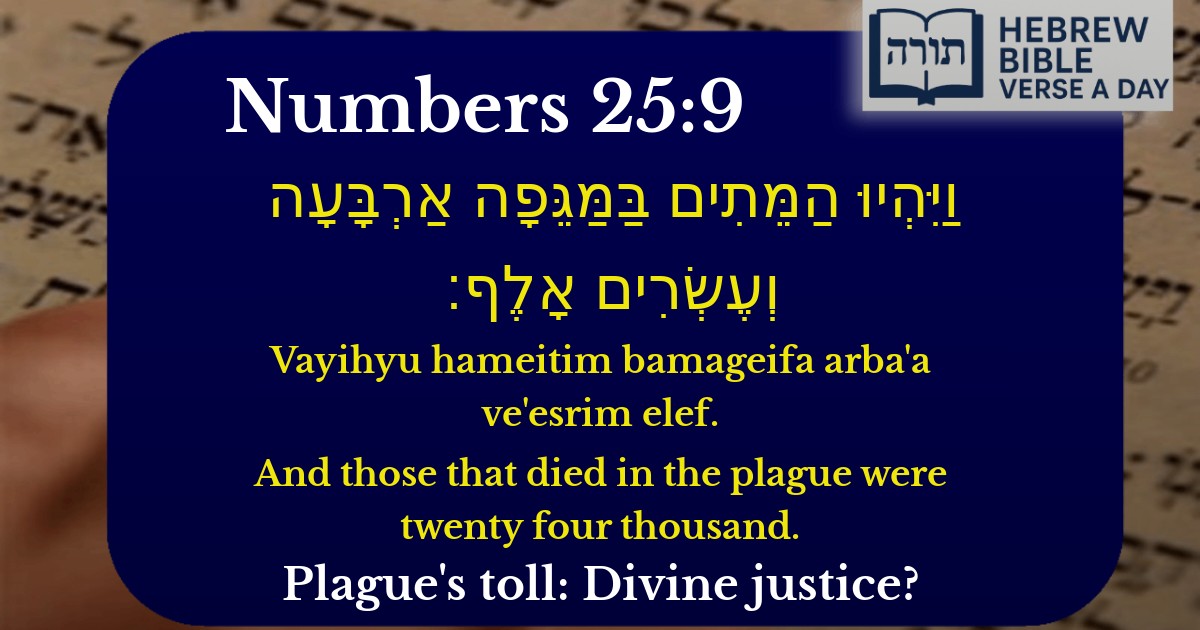Frequently Asked Questions
Q: What plague is being referred to in Numbers 25:9?
A: The plague mentioned in Numbers 25:9 was a divine punishment that struck the Israelites after they sinned with the Moabite women and worshipped the idol Peor (Baal Peor). Rashi explains that this was a result of the Israelites engaging in immoral behavior and idolatry, which violated their covenant with Hashem.
Q: Why did 24,000 people die in this plague?
A: According to the Talmud (Sanhedrin 106a), the 24,000 who died were primarily from the tribe of Shimon, as their leader, Zimri, publicly sinned with a Midianite woman (Kozbi). The Midrash (Bamidbar Rabbah 20:23) teaches that this severe punishment was due to the brazenness of the sin and the need to halt the moral decay among the Israelites.
Q: What lesson can we learn from the plague in Numbers 25:9?
A: The verse teaches the severe consequences of straying from Torah values, especially in matters of morality and idolatry. Rambam (Hilchot De'ot 1:4) emphasizes that one must distance oneself from negative influences to avoid spiritual downfall. The plague serves as a warning about the dangers of assimilation and improper behavior.
Q: How does Pinchas (Phinehas) relate to this verse?
A: Right after this verse (Numbers 25:10-13), Pinchas is praised for his zealousness in stopping the plague by taking action against Zimri and Kozbi. The Talmud (Sanhedrin 82a) explains that Pinchas' intervention demonstrated loyalty to Hashem, which ended the plague and earned him a covenant of peace (Brit Shalom).
Q: Is there any significance to the number 24,000 in Jewish tradition?
A: Yes, the number 24,000 is also associated with the students of Rabbi Akiva who perished during the Sefirat HaOmer period (Yevamot 62b) due to lack of respect for one another. Some commentaries draw a parallel between these tragedies, highlighting the importance of unity and moral conduct in Jewish life.


Context of the Verse
The verse (Numbers 25:9) describes the aftermath of the plague that struck Bnei Yisrael due to their involvement in the sin of Baal Peor. This event occurred when the Israelites were seduced by the Moabite and Midianite women into idolatry and immorality, leading to divine retribution.
Rashi's Explanation
Rashi (Rabbi Shlomo Yitzchaki) comments that the 24,000 who perished in the plague were from the tribe of Shimon. He bases this on the juxtaposition of this verse with the earlier listing of the leaders of each tribe (Numbers 25:14), where Zimri, a prince of Shimon, was publicly involved in the sin. Rashi further notes that this plague was a manifestation of divine justice, as the tribe of Shimon was particularly implicated in the transgression.
Midrashic Insights
The Midrash (Bamidbar Rabbah 21:3) elaborates that the plague was halted through the zealous actions of Pinchas, who executed Zimri and Kozbi, thus atoning for the people. The number 24,000 is also connected to the 24,000 students of Rabbi Akiva who perished during the Sefirah period, drawing a parallel between the consequences of sin and the importance of proper conduct.
Rambam's Perspective
Maimonides (Rambam) in Mishneh Torah (Hilchot Teshuvah 1:4) discusses the severity of communal sin and its repercussions. He explains that the plague served as a collective punishment to purify the nation and reinforce the gravity of abandoning Torah values. The large number of deaths underscores the principle that public desecration of Hashem's name carries severe consequences.
Additional Commentaries